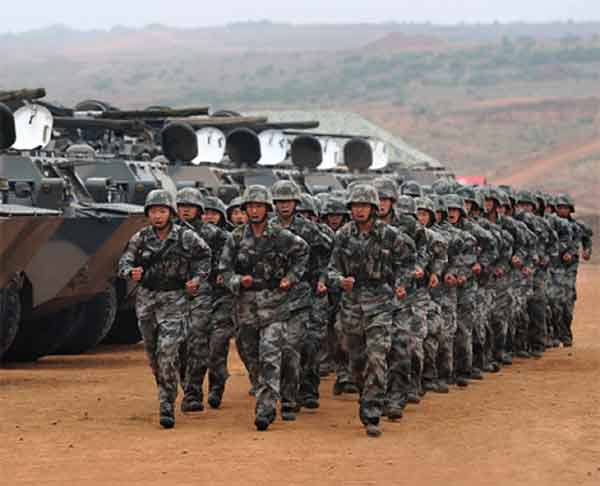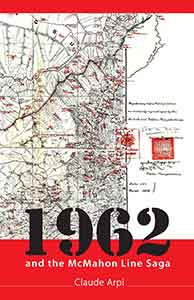Over the past decades, we have constantly tried to mollify the Dragon. In the bargain, we have been inveigled into surrendering our bargaining chips one by one. Therefore, we should now strive to reverse some of this damage. Just as the Chinese have several times changed their stance on Arunachal Pradesh, Sikkim and Jammu & Kashmir, we too must subtly pull back from our commitment to the ‘One-China’ principle, support Tibetan autonomy and the Uyghur’s struggle for religious freedom. Taking a leaf from the Dragon’s book, this shift should be gradual and subtle – over years rather than months.
Nehru’s total lack of strategic sense became apparent soon after independence…
The People’s Republic of China (PRC) emerged from a ‘century of humiliation’ in 1949 after years of war against the Japanese and the KMT. From the outset, the new regime set about consolidating its ‘homeland core’. It swiftly seized control over the outlying buffer territories, gateways to invasion of the ‘core’ in times past, including Xinjiang and Tibet. During the Korean War, when the aggressor North Koreans were driven up to the Yalu River, China’s ultra-sensitivity to the buffer sparked its massive intervention which repulsed UN Forces South of the 38th parallel.
After Mao, China was fortunate to have a far-sighted, visionary leader in Deng Xiaoping. He synergised military and governance by combining Chairmanship over CMC with the position of CCP General Secretary and President. Thus, both Hu Jintao and his successor had several years of exposure to Military Affairs before assuming control of the Party, the Government and the CMC. Xi Jinping is the first leader to be elected to all three posts at the same meeting in March 2013. A ‘princeling’, he is a firm believer in the Mao-dictum, “Power grows out of the barrel of a gun.” Thus, in the next decade, India could face China’s velvet-cloaked iron fist – such as the Depsang intrusion in April-May 2013.
Deng instituted the four-modernisations, which not only pulled China out of the morass that followed the Cultural Revolution, but also catapulted it to the status of a world-power in just twenty-odd years. While China’s galloping economy was transforming it into the manufacturing hub of the world, Deng advised ‘tanguang-yanghui’ – “Hide your strength and bide your time.” Hence, by September 2008, when the sub-prime crisis hit USA, China held the largest share of US sovereign debt – $618 billion. Sensing that the middle-kingdom’s rise was now unassailable, Hu Jintao shed ‘tanguang-yanghui’ and began flexing China’s diplomatic and military muscle.
China is the only nation to actually demonstrate anti-satellite weapon capability…
As China’s super-charged economy’s appetite for energy and mineral resources swelled, she extended her strategic frontiers in phases. First, China laid claim to the oil-rich continental shelf – the North Pacific adjacent to Japan and Russia, the Taiwan Straits, the East and South China Seas right up to the Strait of Malacca. Later, when China began exploiting the Dark Continent she cast her nets to include Middle East and Africa. In December 2008, a Chinese naval task force unilaterally sailed into the Indian Ocean for anti-piracy operations in the Gulf of Aden. Rear Admiral Yin Zhou then proposed that the People’s Liberation Army – Navy (PLAN) set up a permanent base in the Gulf of Aden to support these operations. In January 2009, Huang Kunlun, writing in the Liberation Daily, articulated the theory of boundless national interests, “Wherever our national interests have extended so will the mission of our armed forces.” By April that year, during PLAN’s international fleet review, a Chinese Senior Admiral had a proposal for visiting US Admiral Keating, “Why don’t you take Hawaii East and we’ll take Hawaii West and the Indian Ocean?”
China’s Military Might
- One of Deng’s four modernisations – that of the PLA was taken up as a national endeavour. Special emphasis was laid on developing its 2nd Artillery Forces and for the first time in Chinese history, also on transforming the PLAN into a blue water force. Accordingly, the military budget remained consistently above ten per cent of GDP for over three decades. As China’s economy raced to the world’s second spot, the PLA kept apace and emerged as a well-equipped, modern and formidable military in five dimensions – land, air, sea, space and cyber-space. While it is capable of facing up to the USA, the PLA has also developed a doctrine for ‘winning short duration local wars under high-tech conditions.’ China’s defence industry and technology has developed some remarkable weapon systems:On September 25, 2012, China commissioned its first indigenous, ultra-modern aircraft carrier, Liaoning.
- The hull of China’s first Xia-class SSBN was laid in 1978, launched in 1981 and commissioned by 1983. Its second generation Jin-class SSBN, which was launched in 2004, carries 12×8,000km Jualang-2 SLBMs and poses a 24×7 strategic deterrent to the US and India. Four vessels are already in service and more could be deployed even as the development of its third-generation SSBN nears completion.
- Development of Unmanned Underwater Vehicles – mini-subs to be used either for swarm-attacks or reconnaissance is at an advanced stage.
- China has developed the world’s first hypersonic (Mach 10) anti-shipping ballistic missile, capable of targeting a moving aircraft carrier strike-group at long range.
- China’s fifth-generation stealth fighter, the J-20, made its maiden flight on January 11, 2011, and is expected to be operational in 2017–2019.
- China is the only nation to actually demonstrate anti-satellite weapon capability.
Modernisation of the Indian Army has made no headway, be it in artillery howitzers or replacement of obsolete air-defence systems.
Indian Strategic Muddle
In sharp contrast, Nehru’s total lack of strategic sense became apparent soon after independence when the Commander-in-Chief (C-in-C) General Lockhart, sought the Government’s approval for a defence directive. “We don’t need a defence plan. Our policy is ahimsa; we foresee no military threats,” he told the astonished General, “The police are adequate for our security.” Only weeks later, the Army had to be rushed in to save Kashmir. But Nehru remained unfazed. When the Army was on the verge of completely routing the Pakistani invaders from Jammu & Kashmir, he ordered a halt to operations and went to the UN instead thereby creating what has turned out to be a permanent security nightmare.
The British had striven to bolster Tibetan autonomy to reinforce the buffer with China. On November 07, 1950, Sardar Patel warned Nehru about China’s inimical intentions, barely a month after she had invaded Tibet. Ignoring Patel, Nehru conceded China’s suzerainty over Tibet. In January 1951, the Assam government received reports about Chinese armed incursions across the Tibetan border and requested the C-in-C, General Cariappa to staunch the threat. But Nehru chided him, “It is not the business of the C-in-C to tell the PM who is going to attack us where. In fact, the Chinese will defend our NEFA Frontier. You mind only Kashmir and Pakistan.” In 1952, he down-graded India Mission’s status at Lhasa to a Consulate-General and later withdrew military ‘escorts’ at the trade posts at Yatung, Gyantse and Gartok. All this without seeking any reciprocity or assurances on the boundary!
Then, in a volte-face in July 1954, he ordered Secretary General MEA to reprint the British-era maps by excluding references to any ‘claim lines’ or undefined borders. These would now depict a clear Indo-Tibet boundary and become the basis for negotiating the boundary question. However, he did not consider it necessary to equip the Army for defence of these new-fashioned borders. Thus, India came to know about the road through Aksai Chin, 200 km within our area, only through an article in a Chinese magazine in 1957.
The neglect of the Armed Forces and their demoralisation under Krishna Menon’s acid tongue came to a head in 1959 with the resignation of General Thimayya – one of the saviours of Kashmir. A shaken Nehru sweet-talked the Gentleman General, appealed to his patriotic spirit and promised to correct all the wrongs, thus deceiving him into withdrawing the resignation. Next morning, he talked disparagingly of him in the Parliament.
In February 2013, the Chinese formally took over operations of Pakistan’s Gwadar Port…
In 1962, Nehru announced to the media that he had asked the Army ‘to throw the Chinese out!’ But the Army Chief was informed later, thereby completely marginalising the Services and triggering the 1962 debacle.
Indian Defence Forces: Apathy and Neglect
After a brief wake-up period during which India successfully withstood two Pakistani aggressions, for 35 years it was back to neglect of the Armed Forces with the defence budget languishing below two per cent of GDP – an eighth of Chinese allocations. The results are stark; a story of Babustani apathy and turf wars, missed deadlines and severe strategic disparities:
- The Indian Navy, which needs a three-carrier fleet, is down to one – repeatedly-refitted senior-citizen, Viraat. The inordinately delayed induction of the ‘Gorshkov’, has forced Viraat into yet another extension, impairing the capability to protect our sea-lanes.
- Arihant, India’s first generation nuclear submarine is yet to begin sea-trials. Weapon-trials will ensue and only then would the vessel become operational. Arihant will ultimately carry 12x700km SLBMs. Meanwhile, even the conventional submarine programme has been asphyxiated. Today, we are at two-thirds the submarine-strength sanctioned in 1985, while Chinese capability has made quantum strides.
- The Indian Air Force (IAF) is down to 31 squadrons and its transport fleet whittled to 40 per cent. This will shrink to 28 squadrons since negotiations are still on for the ten-billion dollar contract for 126 Rafale fourth-generation combat aircraft, first proposed by the IAF in 2001. Hence the aircraft is unlikely to be operationalised for at least another decade. As regards the fifth-generation fighter, the contract for joint development with Russia is yet to be signed.
- In a replay of the 1959 humiliation of General Thimayya, MoD’s ham-handed dealing of a personal matter compelled the COAS, General VK Singh to approach the Supreme Court in 2012. Then, attempting to embarrass him, the bureaucracy leaked his top secret letter drawing the PM’s attention to appalling deficiencies and obsolescence in the Army’s in-service arsenal. The leak blew the lid off the Government’s neglect of the force and caused a nation-wide furore. Immediate fire-fighting meetings were called by the Minister of Defence to give the impression that long-delayed action was finally being taken. However, one year later the actual state has only deteriorated further.
.
- Modernisation of the Indian Army has made no headway, be it in the regime of artillery, air-defence systems, night fighting capability or attack helicopters to name just very few of the long list of proposals languishing under Babustan’s strangulation.
- While China has developed first-class infrastructure in Tibet, Babustan has held-up 57 of 73 strategic roads due for completion by 2012-2013 conceding China a major advantage. The Government is belatedly thinking about removing these hurdles.







The only decoding needed is to build up India’s offensive capabilities for facing off both China and Pakistan should they make a move. Nothing less will create any political or policy advantage for India. What China thinks and does will be in the interest of China and not India. China will continue to play with India like a bully plays with weaklings in the street he lives. The only guilty party for this sorry state of affairs is the current UPA government.